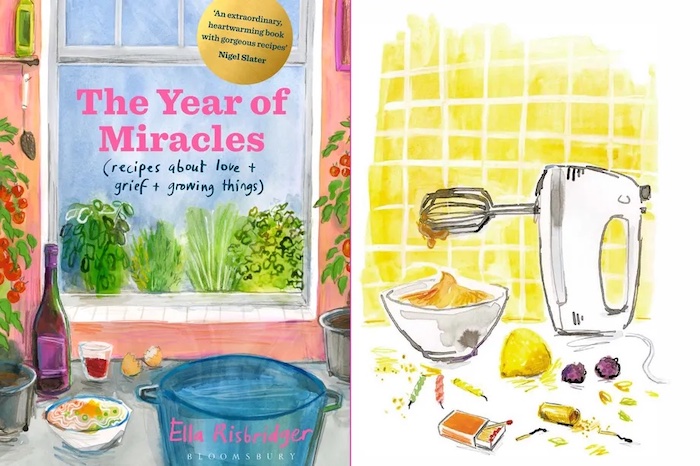— A food memoir about love, grief, and lockdown

In The Year of Miracles, Ella Risbridger cooks through the end of the world.
British journalist Ella Risbridger’s new food memoir The Year of Miracles was not, she informs us in her first sentence, “meant to be” a book about grief. It was meant to be a cheerful little book about hosting dinner parties, a happy follow-up to Risbridger’s 2019 hit Midnight Chicken, about how she cooked as a way of dealing with her depression. “But what can you do?” Risbridger goes on. Grief “gets into everything.”
Part of the charm of Midnight Chicken was the way Risbridger conjured her lovely life onto the page: a life of quirky, cozy, bookish love with her partner the Tall Man (real name John Underwood) in their Tiny Flat. It was marred only by the tragedy tucked away on the back page in the acknowledgments: In the time between Risbridger handing in her manuscript and Midnight Chicken coming out, Underwood had died of a rare form of lymphoma at age 29. (Risbridger gives Underwood, along with the rest of her friends, a pseudonym in The Year of Miracles. Here, he becomes Jim.)
The Year of Miracles is Risbridger’s account of how she cooked her way through the ensuing grief. And because it is, ominously, set in 2020, she is grieving not just the loss of her partner, but also the loss of a whole way of pre-pandemic life.
“This is supposed to be the year when the world, my world, starts again;” Risbridger writes as she first hears news of the pandemic. “This is not the year the world is supposed to end, because my world has already ended.”
The world does not quite end, and Risbridger keeps cooking through it. She cooks Leftovers Pie for her new housemate, because she loves her; Crisis Cardamom Coffee Banana Bread, because everyone made banana bread at the start of lockdown; Turkish Eggs, because Jim would have hated them and he’s no longer there to object.
It’s this last question, of what to do now that Jim is no longer here to make his objections known, that leads Risbridger to some of her most affecting passages. She spent years of her life as Jim’s caretaker, guiding him through chemotherapy and all its accompanying horrors, rendered “subservient, essentially, in a way no other adult relationship demands.” Now that Jim is no longer there, she has space to think through her own preferences, and to deal with the guilt and the horror surrounding that space.
With her housemate, she invents “the Self-Esteem Finger: you hold up one finger, to indicate a desire that has no reference or recourse to anyone else, and you say ‘self-esteem!’” She stops making roast dinners, which Jim loved and she hated, and she indulges in meals with very little meat, such as the Turkish eggs in garlic yogurt.
:no_upscale()/cdn.vox-cdn.com/uploads/chorus_asset/file/23907760/April.jpg)
You can successfully cook from these recipes, more or less. The rice bowl with Vietnamese flavors Risbridger has dubbed Coconut Pow comes out bright and sharp and sweet, although its many parts make it fiddly to put together unless, like Risbridger, you are already in the habit of keeping quick-pickled radishes and salted mango in your fridge. When I followed her recipe for cardamom buns, I found that she’d left out a few details about how to construct them, so that I couldn’t seal them properly and the spiced butter filling leaked out of the buns as they baked. They were still absurdly delicious.
But the recipes here are more indicative of Risbridger’s personality than anything else. They are organized chronologically, with 12 chapters, one for each month of the year, and they are optimized specifically for the way she runs her personal kitchen. As such, she is always specifying the exact color and flakiness of the kind of sea salt you should use, but when a recipe calls for just plain table salt she tells you to pinch your flaky sea salt into dust, because she can never remember to keep plain table salt in stock.
>What you’re really reading for here is Risbridger’s sprightly, evocative prose, which is never more compelling than when she’s describing the sheer joy of her food. Roasted eggplants are “blistered and blackened and chewy and delectable;” fresh dukkah is “a beautiful sunset orange” that makes every salad “a riot;” soy-marinated eggs are “sticky” with “golden, liquid yolks.” Periodically, she peppers her instructions with bossy repetitions (“I do know your life, and you don’t need more flour”) and shameless confessions (“I have a weakness for adding leftover sour cream and chive dip, but I understand this is horrible”).
Bouncing up against Risbridger’s prose are Elisa Cunningham’s whimsical watercolor illustrations, which range in elaborateness from two-page-spread tableaux of the neighbor’s cat in Risbridger’s fire escape garden to half a lemon rolling around the bottom margin of a recipe for parsnip purée. They are sweetly messy sketches, matching the sweetly messy energy of this home cook’s recipe book.
And that, in the end, is what you read The Year of Miracles for: the sweetness and the mess. Cardamom buns that fall apart in the oven but are still buttery and rich with sugar and spices. An account of a life laced with grief that wasn’t supposed to be there, and a world that ends over and over and over again and manages to keep its beauty and its charm regardless.
It’s what makes this cookbook-cum-memoir feel exuberant, unstoppable, and triumphantly on the side of love and life in the face of death and loss and grief.
Complete Article ↪HERE↩!
